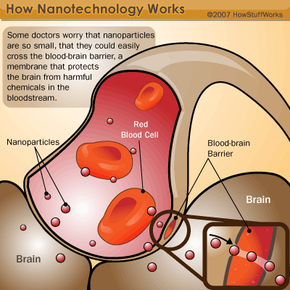Nanotechnology Challenges, Risks and Ethics
The most immediate challenge in nanotechnology is that we need to learn more about materials and their properties at the nanoscale. Universities and corporations across the world are rigorously studying how atoms fit together to form larger structures. We're still learning about how quantum mechanics impact substances at the nanoscale.
Because elements at the nanoscale behave differently than they do in their bulk form, there's a concern that some nanoparticles could be toxic. Some doctors worry that the nanoparticles are so small, that they could easily cross the blood-brain barrier, a membrane that protects the brain from harmful chemicals in the bloodstream. If we plan on using nanoparticles to coat everything from our clothing to our highways, we need to be sure that they won't poison us.
Advertisement
Closely related to the knowledge barrier is the technical barrier. In order for the incredible predictions regarding nanotechnology to come true, we have to find ways to mass produce nano-size products like transistors and nanowires. While we can use nanoparticles to build things like tennis rackets and make wrinkle-free fabrics, we can't make really complex microprocessor chips with nanowires yet.
There are some hefty social concerns about nanotechnology too. Nanotechnology may also allow us to create more powerful weapons, both lethal and non-lethal. Some organizations are concerned that we'll only get around to examining the ethical implications of nanotechnology in weaponry after these devices are built. They urge scientists and politicians to examine carefully all the possibilities of nanotechnology before designing increasingly powerful weapons.
If nanotechnology in medicine makes it possible for us to enhance ourselves physically, is that ethical? In theory, medical nanotechnology could make us smarter, stronger and give us other abilities ranging from rapid healing to night vision. Should we pursue such goals? Could we continue to call ourselves human, or would we become transhuman -- the next step on man's evolutionary path? Since almost every technology starts off as very expensive, would this mean we'd create two races of people -- a wealthy race of modified humans and a poorer population of unaltered people? We don't have answers to these questions, but several organizations are urging nanoscientists to consider these implications now, before it becomes too late.
Not all questions involve altering the human body -- some deal with the world of finance and economics. If molecular manufacturing becomes a reality, how will that impact the world's economy? Assuming we can build anything we need with the click of a button, what happens to all the manufacturing jobs? If you can create anything using a replicator, what happens to currency? Would we move to a completely electronic economy? Would we even need money?
Whether we'll actually need to answer all of these questions is a matter of debate. Many experts think that concerns like grey goo and transhumans are at best premature, and probably unnecessary. Even so, nanotechnology will definitely continue to impact us as we learn more about the enormous potential of the nanoscale.
To learn more about nanotechnology and other subjects, follow the links below.
Related HowStuffWorks Articles
- How Atoms Work
- How Batteries Work
- How Cancer Works
- How Electric Motors Work
- How Electricity Works
- How Electronic Gates Work
- How Fuel Cells Work
- How Microprocessors Work
- How Quantum Computers Will Work
- How Quantum Suicide Works
- How Semiconductors Work
- How Solar Cells Work
- How Virtual Reality Works
- What is superconductivity?
More Great Links
Sources
- "Did you ever wonder about the invisible marvels of the nanoworld?" Berkeley Lab. http://www.lbl.gov/wonder/louie.html
- "Energy Producing Roads Made From Solar Cells and Glass May Be The Solution To Carbon Emissions and Climate Change." Azonano.com. http://www.azonano.com/Details.asp?ArticleID=1969
- "Nanotechnology." Encyclopædia Britannica. 2007. Encyclopædia Britannica Online. 11 Oct. 2007http://search.eb.com/eb/article-9384821
- "Nanotechnology: Past, Present and Future." Sage Crossroads video podcast. April 21, 2004. http://www.sagecrossroads.net/webcast22
- "Nanowires form atomic switch." Nanotechweb.org. January 6, 2005. http://nanotechweb.org/cws/article/tech/21176
- "Nanowires within nanowires." Physicsworld.com. November 8, 2002. http://physicsworld.com/cws/article/news/16393
- "Using Nanowires to Generate Electricity by Harvesting Energy from the Environment." Azonano.com. September 28, 2007. http://www.azonano.com/news.asp?newsID=5036
- "What Are The Biologic Properties Of Silver Related To Wound Infection Control And Healing." Burnsurgery.org http://www.burnsurgery.org/Modules/silver/section2.htm
- Chang, Kenneth. "Nanowires May Lead to Superfast Computer Chips." The New York Times. November 9, 2001. http://query.nytimes.com/gst/fullpage.html?res=9D06E4DF1638F93AA35752C1A9679C8B63
- Cortie, Michael B. "The Weird World of Nanoscale Gold." Gold Bulletin. Vol 37, 2004.
- Cui, Yi. "Nanowires and Nanocrystals for Nanotechnology." Lecture at Stanford University. September 12, 2006. http://video.google.com/videoplay?docid=6571968052542741458
- Freitas, Jr., Robert A. "Nanotechnology, nanomedicine and nanosurgery." International Journal of Surgery. 2005.http://www.nanomedicine.com/Papers/IntlJSurgDec05.pdf
- Gelblum, Amit. "Self-Assembling Nanowires." The Future of Things. September 26, 2007. http://www.tfot.info/news/1010/self-assembling-nanowires.html
- Goldstein, Alan H. "Everything you always wanted to know about nanotechnology." Salon.com. October 20, 2005. http://dir.salon.com/story/tech/feature/2005/10/20/nanotech/
- Kurzweil, Ray. "The Drexler-Smalley Debate on Molecular Assembly." December 1, 2003. http://www.kurzweilai.net/articles/art0604.html
- Stormer, Horst. "Small Wonders - The World of Nanoscience." Lecture. November 14, 2006. http://video.google.com/videoplay?docid=8197935869304489599
- Thomas, Jim, et al. "Nanotechnology." The Ecologist. May, 2003.
